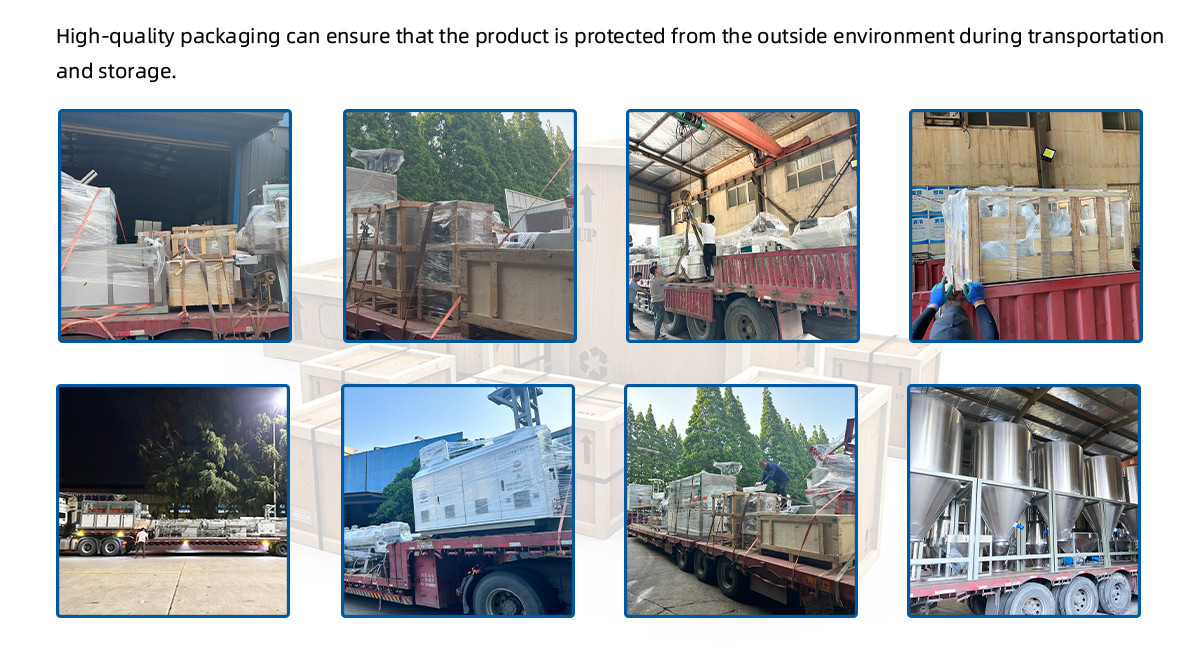▏Product Vedio
▏HDPE/PPR/PPH Pipe Extrusion Machine
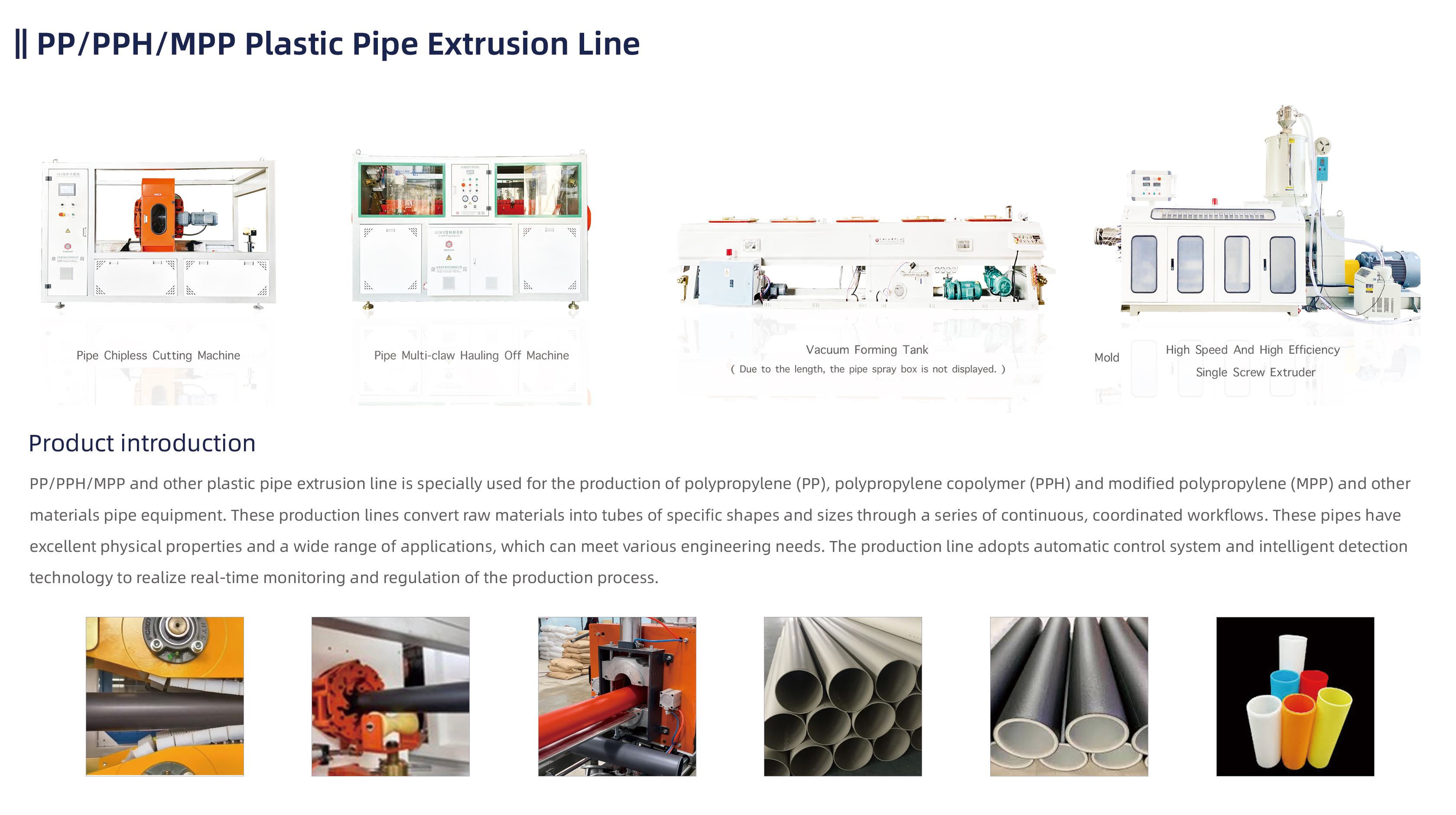
▏Introduction to HDPE/PPR/PPH Pipe Extrusion Machine
The HDPE/PPR/PPH Pipe Extrusion Machine is a high-performance production line designed to manufacture a variety of pipes made from HDPE (High-Density Polyethylene), PPR (Polypropylene Random Copolymer), and PPH (Polypropylene Homopolymer). These pipes are widely used in plumbing, industrial piping, irrigation, and other critical applications due to their exceptional durability, resistance to chemicals, and long lifespan.
This versatile extrusion machine combines advanced technology with precision engineering to ensure efficient production of pipes with consistent quality. By offering flexibility in material choice and pipe specifications, the HDPE/PPR/PPH Pipe Extrusion Machine is a perfect solution for manufacturers aiming to produce high-quality pipes in large volumes while maintaining operational efficiency and cost-effectiveness.
▏Key Features of HDPE/PPR/PPH Pipe Extrusion Machine

 | High-Efficiency Extruder for Diverse Materials
At the heart of the HDPE/PPR/PPH Pipe Extrusion Machine is a high-efficiency extruder designed to process various thermoplastic materials, including HDPE, PPR, and PPH. These materials require precise temperature control and uniform melting to achieve optimal pipe properties such as strength, flexibility, and resistance to chemicals. The advanced screw and barrel design of the extruder ensures excellent material plasticization, preventing degradation and guaranteeing a smooth, consistent flow of material through the die. This is crucial for producing high-quality pipes with uniform wall thickness and smooth surfaces. |
 | Precision Pipe Diameter Control
The HDPE/PPR/PPH Pipe Extrusion Machine offers exceptional precision in pipe diameter control, ensuring consistent production of pipes within tight tolerances. The die head and sizing calibration system are engineered to maintain exact diameters, producing pipes that meet rigorous quality standards. This precision control is essential for industries such as plumbing, construction, and irrigation, where exact pipe dimensions are critical for system compatibility and performance. The ability to produce pipes with various diameters (from small to large) gives manufacturers the flexibility to cater to diverse customer needs. |
 | Advanced Cooling and Calibration System
After extrusion, the pipes pass through an advanced cooling and calibration system that ensures precise shaping and sizing. The cooling system, often including water baths and air cooling units, rapidly cools the pipes while maintaining their structural integrity and dimensional accuracy. The calibration unit plays a vital role in ensuring that the extruded pipes maintain their roundness and uniformity, even at high production speeds. This results in smooth, defect-free pipes ready for downstream processing or direct use in various applications. |
 | Automatic Haul-Off and Cutting Unit
The HDPE/PPR/PPH Pipe Extrusion Machine includes an automatic haul-off and cutting unit that ensures continuous production of pipes with uniform lengths. The haul-off unit applies consistent pulling force to the extruded pipes, maintaining uniformity in the production process. The cutting unit is designed for precision and efficiency, capable of providing clean, chip-free cuts at various lengths. This feature eliminates the need for additional post-processing steps, ensuring that the pipes are ready for packaging or further assembly. |
 | Energy-Efficient Operation
Designed with energy efficiency in mind, the HDPE/PPR/PPH Pipe Extrusion Machine minimizes power consumption while maximizing production output. The advanced heating and cooling systems are optimized for low energy use, reducing operational costs and minimizing the environmental impact of the manufacturing process. This energy-efficient design is particularly beneficial for manufacturers looking to improve profitability and reduce their carbon footprint, making the extrusion machine an environmentally responsible investment. |
▏Range Of Application
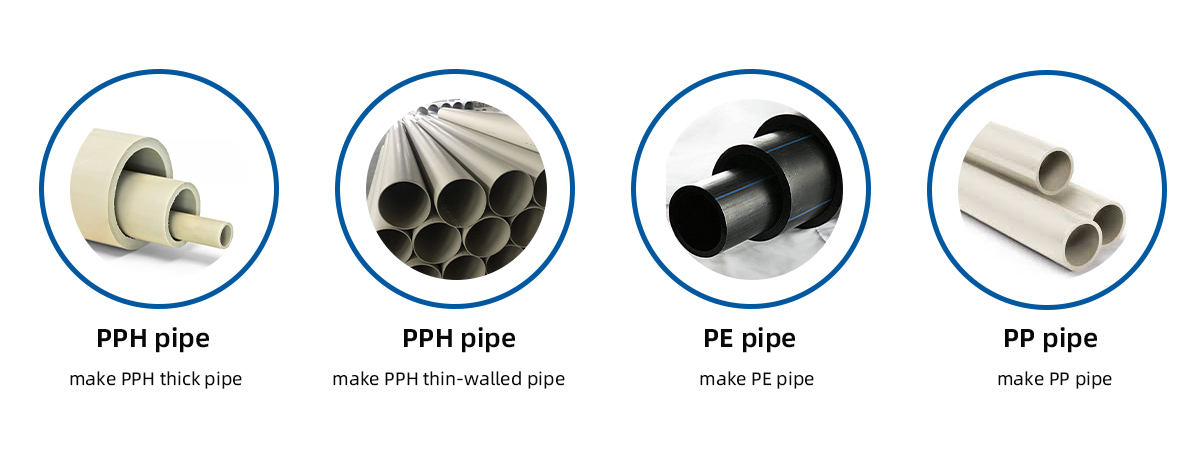
▏Customer Case
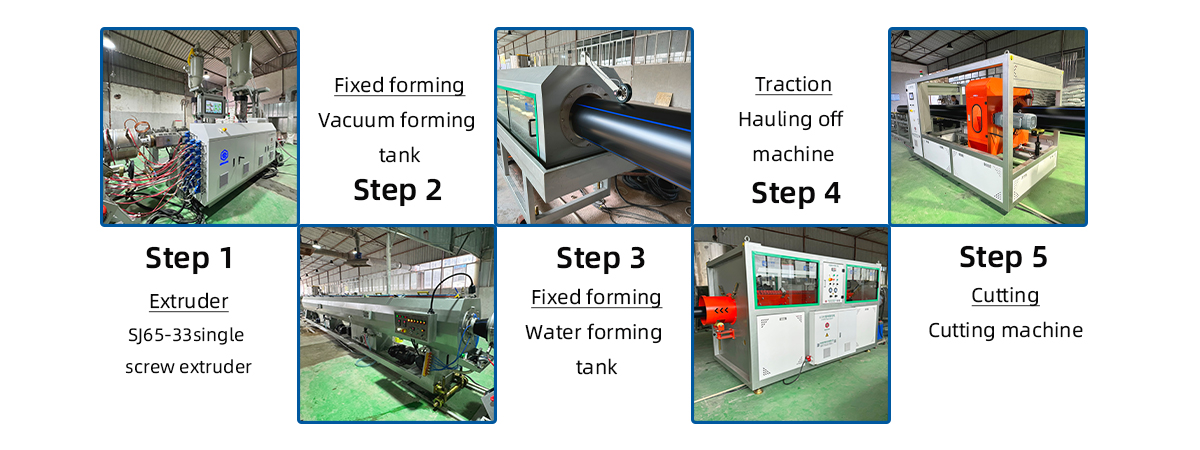
▏Product Photos
▏How the HDPE/PPR/PPH Pipe Extrusion Machine Works
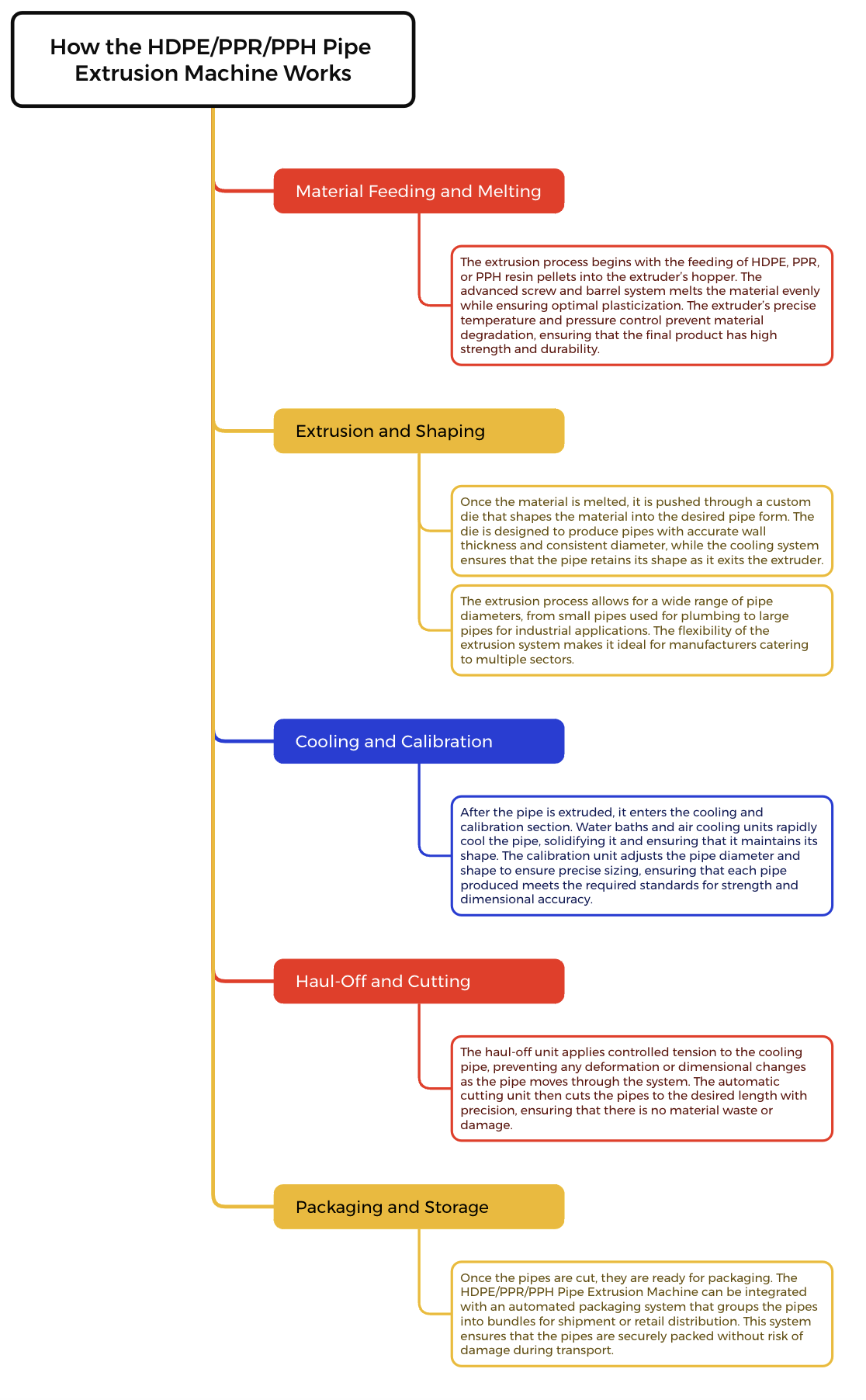
▏Applications of HDPE/PPR/PPH Pipes
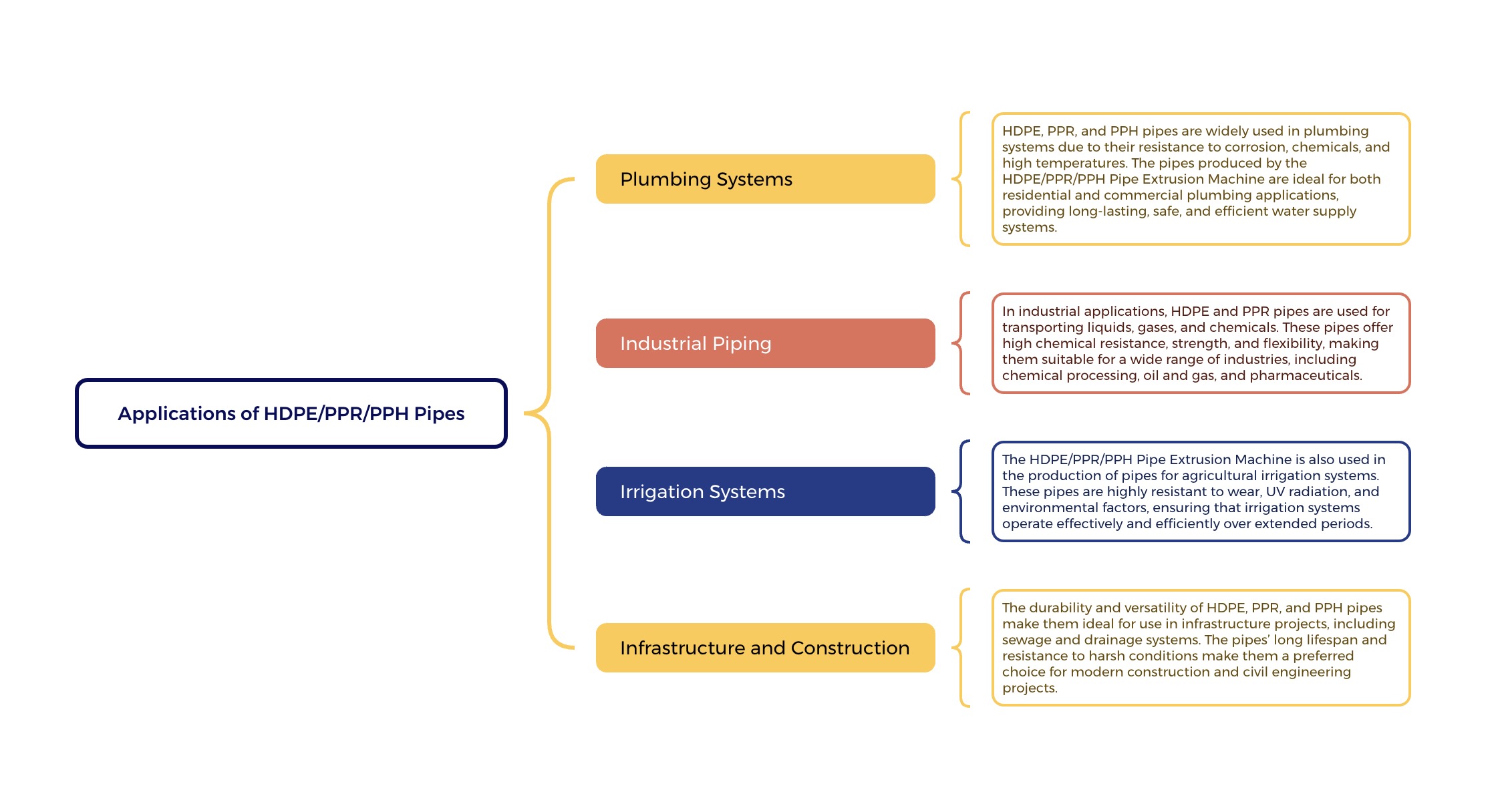
▏Benefits of HDPE/PPR/PPH Pipe Extrusion Machine
 | 1. High Production Capacity
The HDPE/PPR/PPH Pipe Extrusion Machine is capable of high-speed production, allowing manufacturers to produce large quantities of pipes in a short period. This results in lower production costs and faster turnaround times for orders. |
 | 2. Customization and Flexibility
The machine’s flexible design enables manufacturers to produce a variety of pipe sizes, wall thicknesses, and materials. This customization allows manufacturers to cater to diverse market needs, from residential plumbing to industrial applications. |
 | 3. Consistent Product Quality
With its advanced control systems, the HDPE/PPR/PPH Pipe Extrusion Machine ensures high precision and uniformity in the pipes produced. Consistent wall thickness, smooth surfaces, and precise dimensions are crucial for meeting industry standards and customer requirements. |
 | 4. Energy Savings and Environmental Responsibility
The machine’s energy-efficient operation reduces energy consumption, helping manufacturers cut down on operational costs while contributing to a greener, more sustainable production process. |
 | 5. Durability and Long Lifespan
The robust design and high-quality components of the HDPE/PPR/PPH Pipe Extrusion Machine ensure reliable and long-lasting performance. This translates to reduced maintenance needs and increased uptime for manufacturers, maximizing productivity. |
▏Boosting Pipe Production with the HDPE/PPR/PPH Pipe Extrusion Machine
The HDPE/PPR/PPH Pipe Extrusion Machine is a versatile, high-performance solution for manufacturers looking to produce a wide range of pipes for plumbing, industrial, irrigation, and infrastructure applications. With its ability to process multiple materials, offer precise control over pipe dimensions, and optimize production efficiency, this extrusion machine is an essential tool for producing high-quality, durable pipes.
By investing in the HDPE/PPR/PPH Pipe Extrusion Machine, manufacturers can enhance their production capabilities, reduce operational costs, and meet the growing demand for reliable piping solutions in various industries.
▏Product Details
PPH pipe, full name Polypropylene Homopolymer pipe, is a kind of high-performance and environmentally friendly plastic pipe, which is widely used in the fields of building water supply and drainage, chemical industry, agricultural irrigation and so on. The following sections of the PPH pipe production line will be introduced in detail.
| 1 | Raw material preparation |
| Before the HDPE/PPR/PPH pipe extrusion line is started, it is first necessary to prepare HDPE/PPR/PPH pellet raw materials. These raw materials need to meet certain quality requirements, including purity, particle size distribution, etc. In the process of raw material preparation, it is also necessary to carry out necessary pretreatment of raw materials, such as screening, drying, etc., to ensure that the quality of raw materials meets the production requirements. |
| 2 | Heating and melting |
| After the raw material enters the HDPE/PPR/PPH pipe extrusion line, it is first fed into the heating and melting equipment. In this device, the raw material is gradually transformed from a solid state to a molten state by heating at high temperatures. The heating temperature and time need to be adjusted according to the nature of the raw material and production requirements to ensure that the melting effect meets the production needs. |
| 3 | Injection molding |
| The molten PPH raw material is injected into the injection mold, and through the cooling and shaping of the mold, a certain length and diameter of the pipe is formed. Injection molding is a key link in the production of PPH pipes, which has an important impact on the quality and dimensional accuracy of pipes. Therefore, it is necessary to strictly control injection pressure, speed, temperature and other parameters to ensure the quality of pipe forming. |
| 4 | Spray cooling |
| The temperature of the pipe after injection molding is high, and it needs to be cooled immediately. Spray cooling is a common cooling method, by spraying cooling water to the surface of the pipe, the pipe is cooled quickly and shaped. In the process of spray cooling, it is necessary to control the temperature, flow rate and spray mode of cooling water to avoid damage to the pipe. |
| 5 | Cutting and polishing |
| The spray cooled pipe needs to be cut and polished. Cutting is to cut the pipe into a length that meets the requirements, and grinding is to remove the burrs and uneven parts on the surface of the pipe, so that the surface of the pipe is smoother and smoother. This step not only affects the appearance quality of the pipe, but also has an important impact on the subsequent installation and use. |
| 6 | Pipe cutting |
| The cut and polished pipe needs to be further cut to the required length and specification. In the cutting process, it is necessary to ensure the dimensional accuracy and section quality of the pipe to meet the needs of customers. |
| 7 | Quality testing |
| Quality inspection is an important link in HDPE/PPR/PPH pipe extrusion line. Through the inspection of the appearance quality, dimensional accuracy, mechanical properties and other aspects of the pipe, to ensure that the pipe meets national standards and customer requirements. For pipes that do not meet the requirements, they need to be reworked or scrapped. |
| 8 | Storage |
| The PPH pipe that has passed the quality inspection will be sent to the warehouse for storage. During the storage process, it is necessary to keep the warehouse dry, ventilated and clean to avoid moisture, deformation or damage to the pipes. At the same time, it is also necessary to classify, identify and record the pipes in order to facilitate subsequent management and use. |
▏About Us
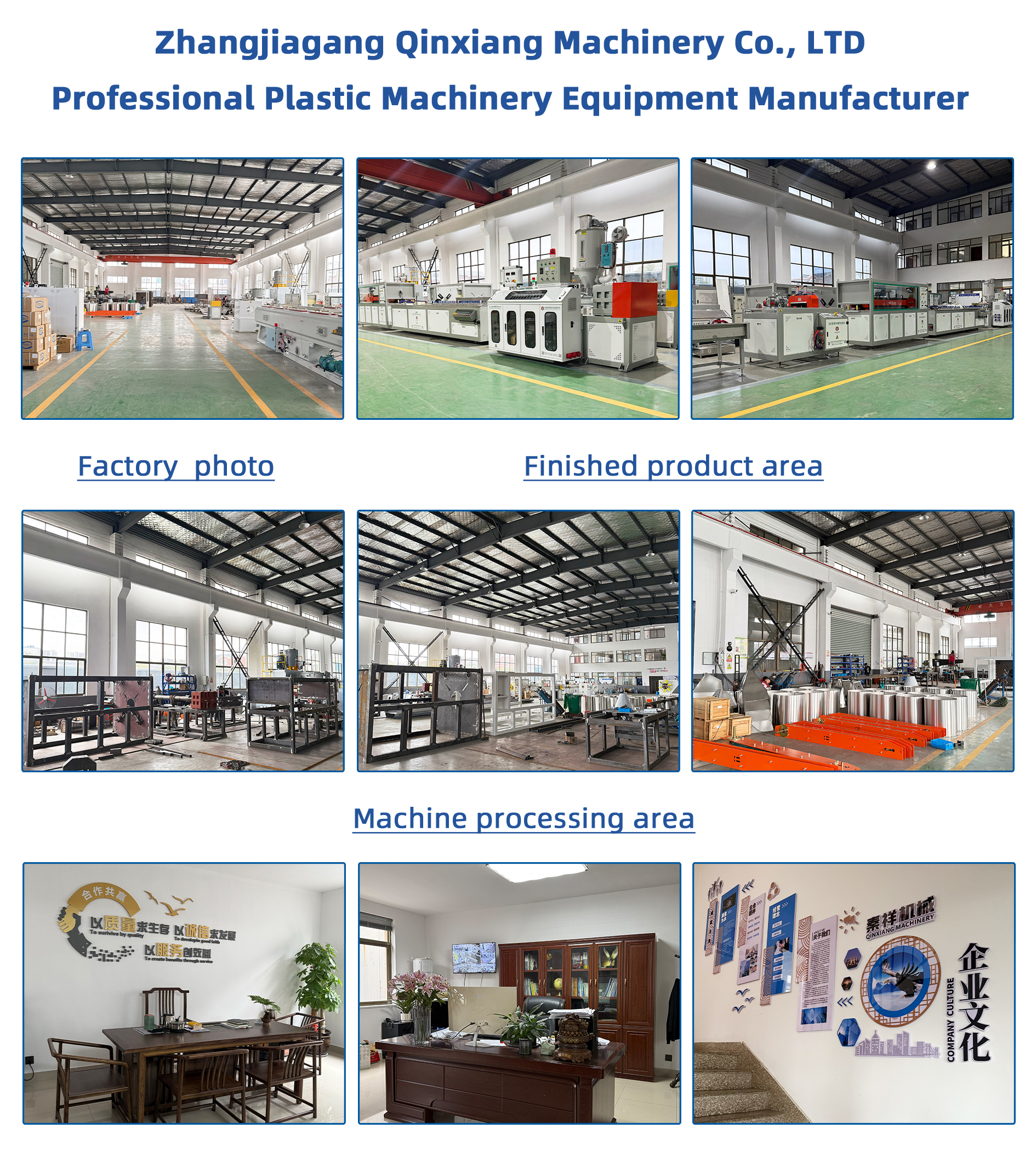
▏Corporate Culture
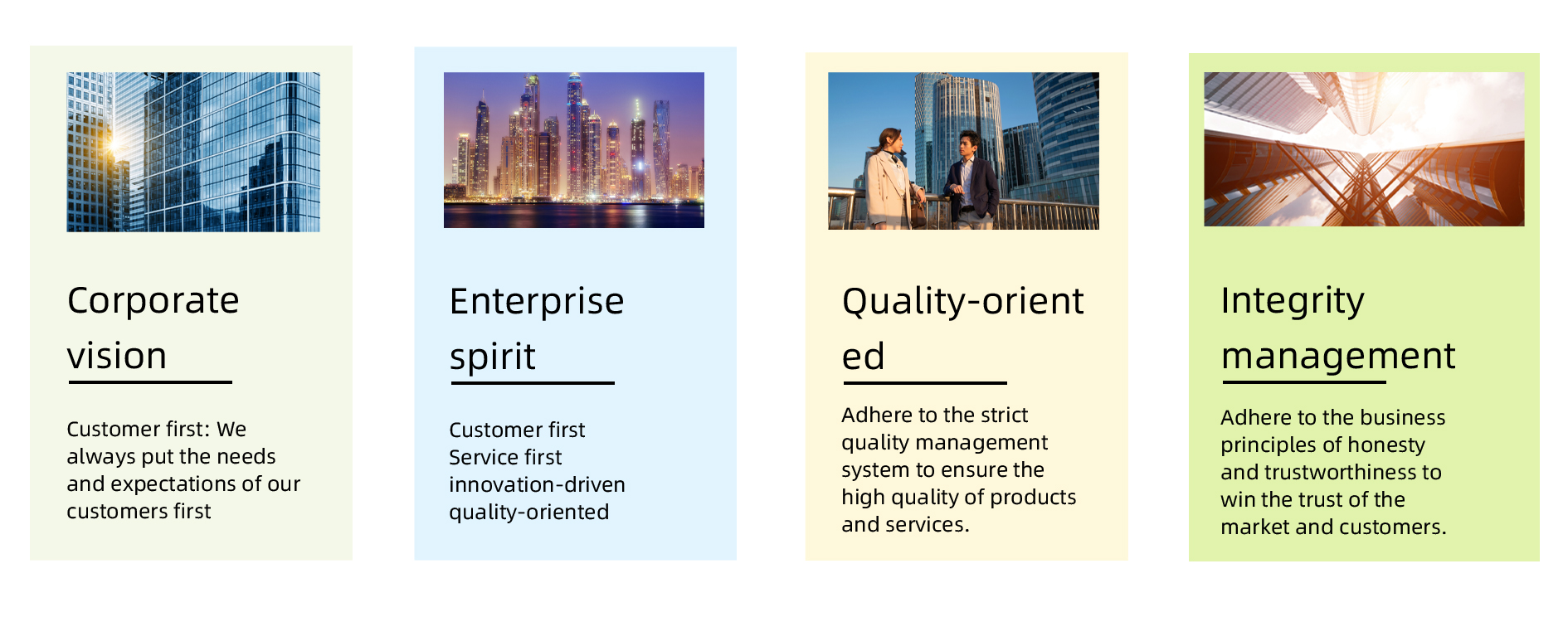
▏Cooperative Parts Supplier
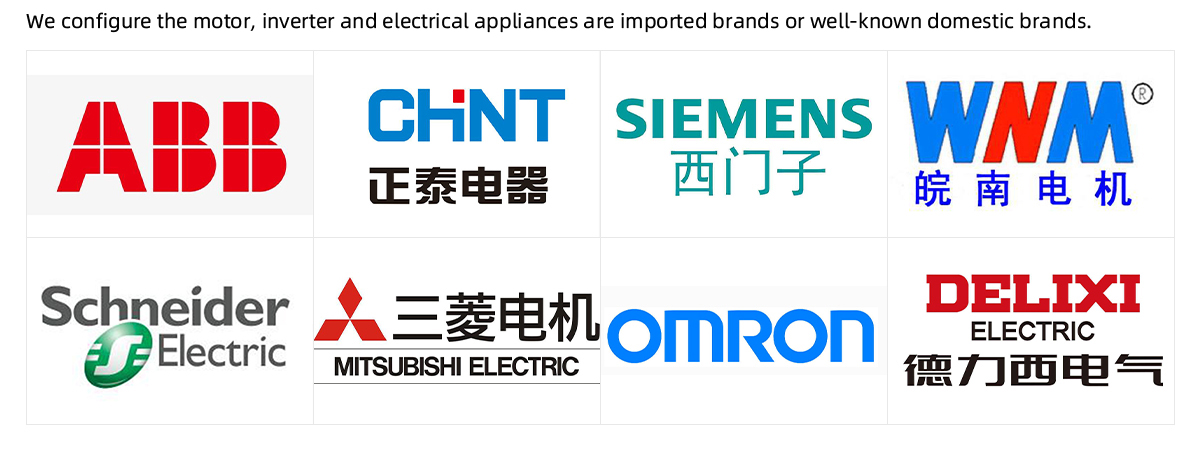
▏Packing And Shipping
